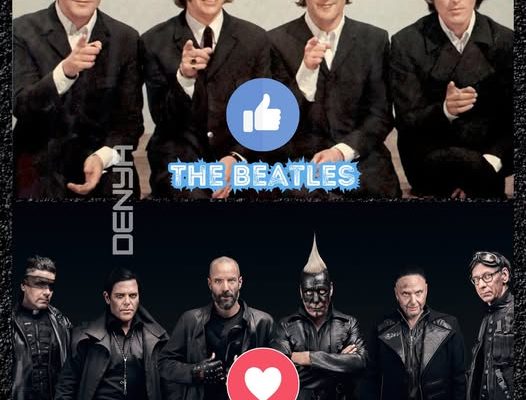Music is more than melodies and rhythms—it is the pulse of cultural identity, the language of collective emotion, and a vehicle for political, social, and economic power. In the twentieth and twenty‑first centuries, few musical acts have shaped that power more dramatically than The Beatles and Rammstein—though in wildly different ways. From the gentle uprising of pop in the 1960s to the thunderous spectacle of industrial metal, these two forces changed not only how music sounded, but how it traveled, how it was consumed, and what it meant to connect across borders. Their stories illuminate the evolution of music’s global power: from soft cultural diplomacy to unapologetic sonic megaphones.
In 1963, John Lennon, Paul McCartney, George Harrison, and Ringo Starr were just four young men from Liverpool trying to make their mark. Yet within a few years they would become the most famous band in the world. Their rise coincided with the emergence of mass media: television, vinyl records, radio syndication, and later satellite broadcasting—all technologies that shrank the world. The Beatles exploited these platforms not merely as tools of exposure, but as creative spaces. They transformed the recording studio into an instrument itself, layering tape loops, reverse effects, orchestration, and electronic innovations — pushing pop music into new frontiers
Their appearance on The Ed Sullivan Show in February 1964 was a cultural earthquake: about 70 million Americans watched that night, and Beatlemania went global almost overnight They became the face of the British Invasion, shifting the center of pop influence from the United States back to the UK—and demonstrating that youth culture, packaged as music, could transcend language and geography.
But the Beatles did not rest on fame alone. As their sound matured, they became relentless explorers of musical possibility, drawing from folk, Indian classical, avant‑garde, psychedelia, and studio experimentation. George Harrison’s encounters with Ravi Shankar infused songs like “Within You Without You” with Eastern instrumentation and spiritual dimension—linking Western pop with Indian musical tradition in a way that millions heard and internalized.Their songwriting grew deeper and more introspective. Instead of simple love songs, they explored identity, alienation, revolution, temporality. The shift transformed the idea of what a pop group could talk about. In doing so, they rewrote the contract between artists and audiences
Because audiences worldwide heard themselves in The Beatles—whether through melodic hooks or lyric reflections—the band became a kind of cultural lingua franca. By demanding that they control their artistic direction, launching Apple Records, and insisting on autonomy, they exposed the power asymmetries in the music industry and inspired future generations to resist them.They proved that artistry and mass appeal need not be antagonistic.
By the time they disbanded in 1970, their model had already infused countless genres: progressive rock, conceptual albums, studio-based art pop, even hip-hop sampling owes something to their structural daring. Their presence on rotating global radio, multiple generations of tribute acts, remixes, and resurrections (as in Anthology, Get Back) shows that their influence is not only historical but alive.
Still, the Beatles’ power lay in persuasion, in weaving emotional affinity, and in soft persuasion. Their global reach was forged by cultural curiosity and heartfelt connection.
Now fast forward to the mid‑1990s Berlin, in a Germany newly reunited, where Rammstein emerged out of industrial neighborhoods with a machine‑like ferocity, unapologetic theatricality, and blistering sonic force. Their music pulverized the boundary between heavy metal, industrial electronics, and performance art. What set them apart wasn’t just volume or aggression—it was how they turned the stage into a crystal palace of fire, projection, and shock, and how they made the German language itself a weapon of global resonance.
From the beginning, Rammstein embraced the idea that power in music could be visual, symbolic, even confrontational. Their name itself derives from the Ramstein airshow disaster—a foreboding reference to catastrophe as performance. Their early performances were already marked by pyrotechnics, costume, and spectacle, turning concerts into violent rituals They fused crushing guitar riffs, pulsing synthesizers, pounding percussion, and Till Lindemann’s deep, commanding vocals sung in German—a daring choice in a genre still dominated by English.
Their breakthrough came with Sehnsucht (1997), anchored by the track “Du Hast.” The song became a metal anthem internationally, even in markets where few listeners spoke German. The raw emotional punch transcended semantics.They toured with American nu-metal acts, infiltrated soundtracks, and played festivals across continents—brutally demonstrating that language need not limit reach when the spectacle and aggression hit visceral registers.
Every Rammstein show is engineered to overwhelm—not as a sideshow, but as the central act. Pyrotechnics, flame cannons, choreographed theatrics, costumed rituals—they are part of a carefully conceived Gesamtkunstwerk, a total work of art. Their concerts have become pilgrimages, where being there matters as much as listening.
Their influence extended beyond performance. Rammstein helped define the Neue Deutsche Härte (New German Hardness) genre, which merged metal with industrial, electronic, and martial rhythms. They inspired countless European rock and metal bands to experiment with language, theatricality, and sonic density. They also demonstrated how to build mystique and control information—sidebar controversies, censorship, and bold artistic statements only fueled interest. Their approach showed that intensity, consistency, and image coherence could carve a global niche even from non‑English roots.
In contrast to the Beatles’ soft persuasive diplomacy, Rammstein’s global power lies in projection, spectacle, and disruption. Their music does not invite—it confronts.
Yet despite their differences, comparing The Beatles and Rammstein reveals deeper patterns about how music’s global power evolved.
First, they both illustrate how technologies of distribution magnify musical reach. The Beatles exploited radio, television, vinyl, and satellite broadcasting to attach themselves to a global cultural infrastructure. Rammstein benefit from a world saturated with streaming, social media, massive festival circuits, and instantaneous video sharing. In neither case was merely having good songs enough; it was about orchestrating presence in every medium available.
Second, both transformed the relationship between local authenticity and global resonance. The Beatles remained English; their accents, sensibilities, and identities shaped their appeal. Yet fans across Tokyo, Lagos, Rio sang along, made covers, adapted them into new languages. Rammstein remained unapologetically German—even when that choice could have limited them—but audiences globally still chanted “Du Hast.” In both instances, authenticity—rather than translation—became a cross-border magnet.
Third, they both rewrote what live performance could mean. The Beatles moved concerts from club madness to stadium spectaculars (e.g. their 1965 Shea Stadium concert, a milestone in live music). (TIME) Rammstein transformed concerts into full sensory onslaughts, where the stage is a theater of demolition and trance. They taught the industry that footprint matters: what transpires live is as essential as what is recorded.
Fourth, both used mythology, narrative, and image as integral tools. The Beatles’ path was wrapped in mythology—“just four lads from Liverpool,” mop-top imagery, psychedelic mystique, the Apple label legend. Their brand told a story. Rammstein’s narrative is mythic spectacle—fire, darkness, taboo, monstrous beauty. Their visuals, album art, stage persona, and controversy are inseparable from the music. In both, the narrative is part of the medium.
Finally, their enduring legacies underscore how power in music is generational. While many acts fade, The Beatles continued to feed new fans, inspire reinterpretations, and anchor pop music’s evolution. Rammstein, now decades into their career, remain at the vanguard of industrial metal’s global presence, relentlessly touring and renewing their spectacle. Their ability to summon loyalty across generations proves that power in music is sustained, not granted.
So what does the journey “from melody to mayhem” tell us about music’s global power? It suggests that power in music is not a fixed gauge but a shifting topology. In the Beatles era, power was persuasion—sweeping listeners in with melody, harmony, lyrical openness. In the Rammstein paradigm, power is confrontation—imposing presence, spectacle, transgression. In between lies the path of pop, rock, hip-hop, EDM, world music, and beyond.
Today’s artists must negotiate both dictates: how to seduce and how to shock; how to scale and how to subvert; how to remain local and how to globalize. The lessons of the Beatles remind us that openness, vulnerability, sonic innovation, and emotional resonance are enduring currencies. The lessons of Rammstein remind us that spectacle, consistency, iconography, and audacity still generate influence. Together, they map the terrain of music’s evolving global power



